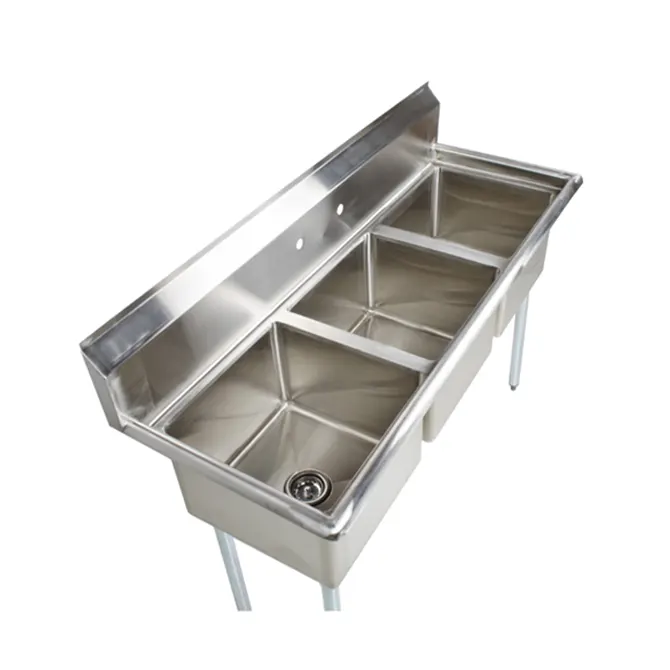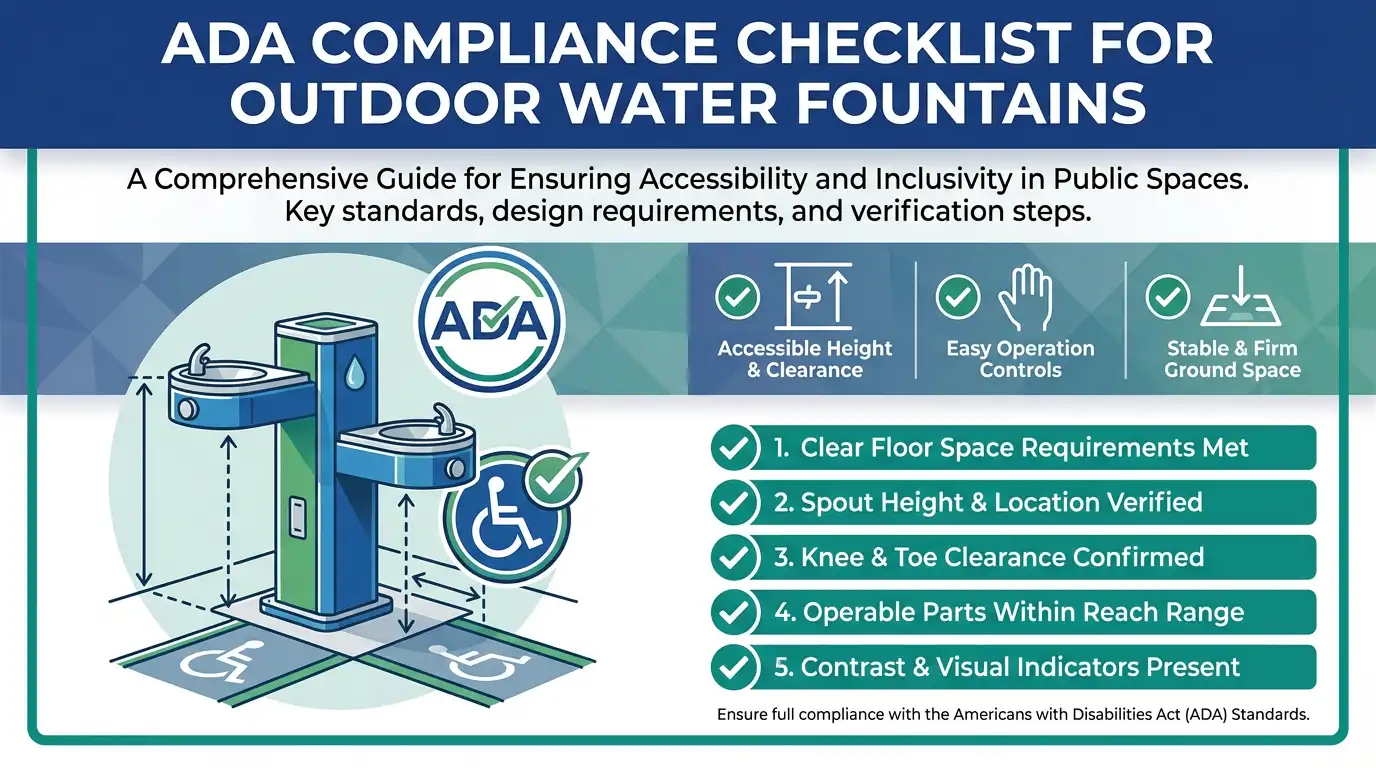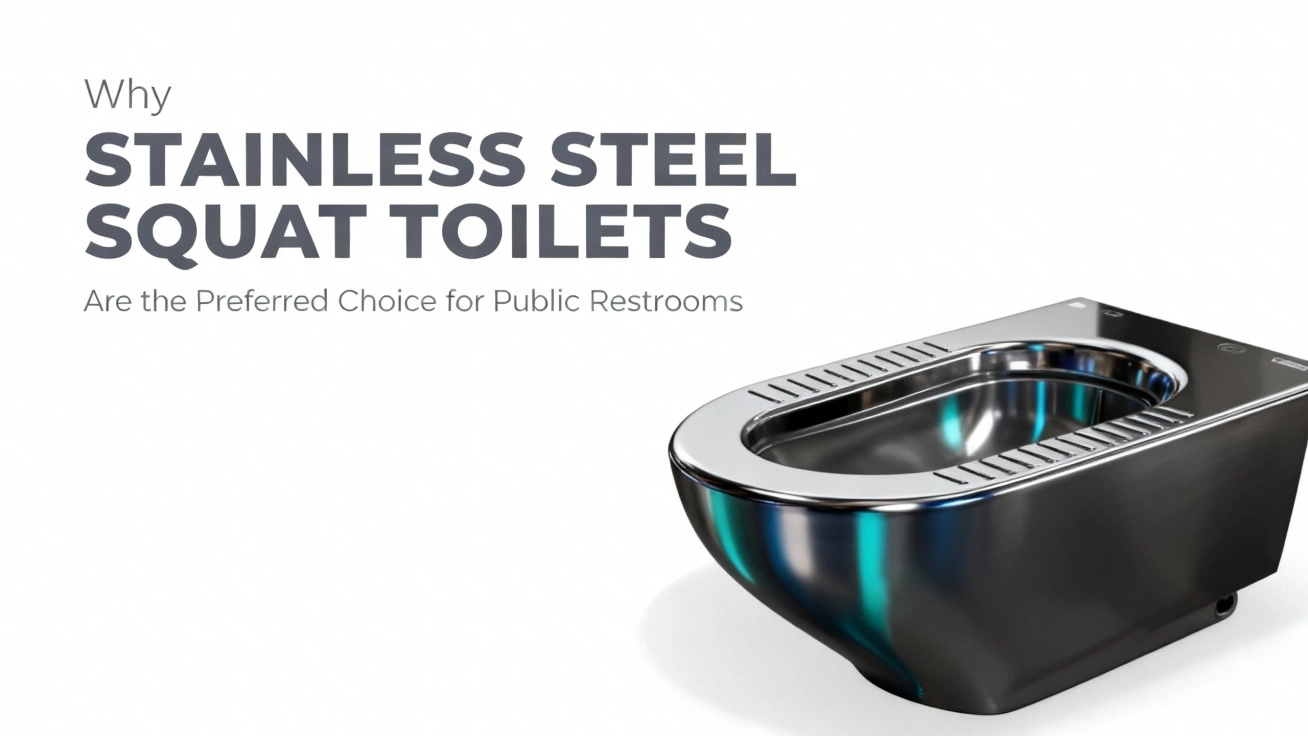3 Compartment Sink: Rules, Order, and Steps
- The first compartment uses warm soapy water (110°F-120°F) to thoroughly wash dishes and remove food residue.
- The second compartment uses clean water to rinse off all detergent.
- The third compartment uses sanitizing solution at proper concentration (such as 50-100ppm chlorine solution) or hot water (≥171°F) for sanitization.
What is a 3 Compartment Sink
A 3 compartment sink, as the name suggests, is a washing system composed of three separate but adjacent sink basins. This design is not coincidental, but rather the physical embodiment of a scientifically validated optimal cleaning process.
The basic structure of a 3 compartment sink:
- First compartment (Wash area): Used for initial cleaning to remove visible food residue and dirt
- Second compartment (Rinse area): Used to remove detergent residue
- Third compartment (Sanitizing area): Used to kill invisible harmful microorganisms
Most 3 compartment sinks are made from high-quality stainless steel, offering excellent corrosion resistance and rust protection. Even in the humid, high-heat environment of a kitchen, they hold up well without aging or damage. Plus, the smooth stainless steel surface doesn’t trap dirt, making cleaning and maintenance a breeze. It’s one of the best material choices for commercial kitchen washing equipment.
This three-step design ensures the integrity of the cleaning process, prevents cross-contamination, and minimizes the survival rate of harmful pathogens.
Regulatory Requirements for 3 Compartment Sinks
In the United States, the use of 3 compartment sinks is regulated by multiple levels of regulations:
FDA Food Code Requirements
The FDA Food Code clearly stipulates that all manually washed tableware and kitchen utensils must go through three steps: washing, rinsing, and sanitizing. Specific requirements include:
- Wash water temperature not lower than 110°F (43.3°C)
- Water temperature or chemical sanitizer concentration in the sanitizing area must meet specified standards
- Dishes must air dry naturally after sanitizing and should not be dried with cloth
State and Local Health Regulations
States and local governments may have stricter regulations, such as:
- Requiring regular testing and recording of sanitizer concentration
- Specifying higher water temperature standards
- Requiring clear operational guidelines to be posted next to sinks
Health inspectors will pay special attention to the use of 3 compartment sinks during routine inspections, and non-compliance may result in severe fines or even business closure.
Correct Washing Sequence
The use of a 3 compartment sink must strictly follow the order from left to right (or right to left, depending on the design), with each step serving an irreplaceable function:
First Compartment: Wash Area
- Fill with hot water at 110°F to 120°F (43.3°C to 48.9°C)
- Add an appropriate amount of dish detergent to form soapy water
- Use a dish brush or scrubbing pad to thoroughly scrub each dish
- Remove all visible food residue and grease
Why it’s important: Only when this step is thoroughly completed can the subsequent rinsing and sanitizing be effective. Remaining food particles will reduce sanitizing effectiveness and provide an environment for bacterial growth.
Second Compartment: Rinse Area
- Fill with clean water, temperature around 110°F (43.3°C)
- Completely immerse washed dishes in water
- Ensure all detergent is completely rinsed off
Why it’s important: Residual detergent can not only contaminate food but also neutralize the sanitizer in the third compartment, reducing its effectiveness.
Third Compartment: Sanitizing Area
Depending on the sanitizing method used, there are two main options:
- Hot water sanitizing:
- Water temperature must reach at least 171°F (77.2°C)
- Dishes need to be fully immersed for at least 30 seconds
- Chemical sanitizing:
- Use an approved chemical sanitizer (such as chlorine bleach)
- Mix to the correct concentration according to manufacturer’s instructions
- Dishes need to be immersed for the specified time (usually 1-2 minutes)
Why it’s important: This is the key step to kill invisible microorganisms and is the last line of defense for food safety.

Detailed Step-by-Step Guide
Preparation
- Empty all sinks and ensure surfaces are clean
- Prepare necessary supplies:
- Detergent
- Approved sanitizer
- Test strips (for checking sanitizer concentration)
- Thermometer
- Dish brush and scrubbing pads
- Timer
- Ensure drainage system is clear
- Remove large food debris from dishes
Water Temperature and Sanitizer Requirements
Wash Area:
- Water temperature: 110°F to 120°F (43.3°C to 48.9°C)
- Detergent amount: According to product instructions, typically 1 oz/gallon of water
Rinse Area:
- Water temperature: Around 110°F (43.3°C)
- Maintain clean water quality, replace when necessary
Sanitizing Area (choose one):
- Hot water sanitizing: Above 171°F (77.2°C)
- Chlorine-based sanitizer: 50-100ppm concentration, water temperature 75°F-120°F (24°C-49°C)
- Iodine sanitizer: 12.5-25ppm concentration, water temperature 75°F-120°F (24°C-49°C)
- Quaternary ammonium: According to manufacturer’s instructions, typically 200-400ppm
Immersion Time Requirements
- Hot water sanitizing: At least 30 seconds
- Chlorine-based sanitizer: At least 7 seconds (for 50ppm concentration) or at least 10 seconds (for 50-100ppm concentration)
- Iodine sanitizer: At least 30 seconds
- Quaternary ammonium: At least 30 seconds or according to manufacturer’s instructions
Drying Process
Sanitized dishes should be placed on clean dish racks to air dry naturally. Never wipe with cloths. This is because wiping may reintroduce bacteria, destroying the sanitizing effect. Ensure that dish racks are regularly cleaned and sanitized to avoid becoming a source of contamination.
Stainless steel sinks and drain racks usually have good drainage performance. Their resistance to chemical corrosion makes them great for environments with frequent disinfectant use.
Common Errors and Solutions
Dangers of Skipping Steps
Some busy employees may try to save time by skipping the rinse step or shortening the sanitizing time. This is an extremely dangerous practice that may lead to:
- Chemical sanitizers being neutralized by detergent, rendering them ineffective
- Bacteria not being completely killed, rapidly multiplying in moist environments
- Significantly increased risk of foodborne illness outbreaks
Solution: Develop standard operating procedures, conduct regular training, and implement supervision and inspection mechanisms.
Incorrect Water Temperature or Concentration
Incorrect water temperature or sanitizer concentration seriously reduces washing effectiveness:
- Water too cold: Cannot effectively remove grease and kill bacteria
- Water too hot: May solidify protein residue, making cleaning more difficult
- Sanitizer concentration too low: Cannot effectively kill germs
- Concentration too high: May leave harmful residue, endangering health
Solution: Equip accurate thermometers and test strips, regularly check and record water temperature and concentration data.
Risk of Cross-Contamination
When cleaning processes are improper, bacteria may spread from one dish to another:
- Water becomes dirty but is not replaced in a timely manner
- Different types of dishes are mixed (such as raw and cooked food utensils)
- Sanitized dishes are placed on unclean surfaces
Solution: Regularly replace water, wash different types of dishes in separate batches, and keep work areas clean and tidy.

Training and Supervision
Key Points for Employee Training
- Principles and importance of the 3 compartment sink
- Detailed demonstration of operational procedures
- Correct methods for measuring temperature and sanitizer concentration
- Identification and resolution of common problems
- Basic food safety knowledge
It is recommended that new employees practice operations at least three times under the guidance of experienced colleagues to ensure complete mastery of procedures.
Establishing Supervision Systems
- Designate experienced employees as supervisors
- Create clear checklists
- Conduct regular surprise inspections
- Promptly correct and follow up on identified issues
Documentation
Maintaining the following records helps demonstrate compliance:
- Daily temperature and sanitizer concentration testing logs
- Employee training records
- Equipment maintenance and calibration records
- Problem and corrective action records
Frequently Asked Questions
What If You Don’t Have a 3 Compartment Sink?
Small establishments may consider:
- Using portable 3 compartment sinks
- Using a combination of dishwasher and single-compartment sink (ensuring the dishwasher has appropriate rinsing and sanitizing functions)
- Using commercial dishwashers with sanitizing functions as alternatives to manual washing
Whatever alternative is adopted, it must ensure the implementation of all three steps: washing, rinsing, and sanitizing.
Automatic Dishwasher vs. 3 Compartment Sink
Automatic dishwasher advantages:
- Higher efficiency, suitable for large batch washing
- Usually higher water temperature, better sanitizing effect
- Greater consistency in operation, reduced risk of human error
3 compartment sink advantages:
- Lower initial investment cost
- Suitable for washing large or specially shaped utensils
- No need to wait for dishwasher cycles to complete, can immediately wash urgently needed items
- Simple structure, easy to maintain, stainless steel sinks have strong durability and impact resistance, able to handle frequent use
Sanitizer Selection Recommendations
- Chlorine-based sanitizers (such as bleach): Economical, broad-spectrum germicidal, but may cause metal corrosion and has an irritating odor
- Iodine sanitizers: Effective against a variety of microorganisms, less irritating, but may cause plastic discoloration and higher cost
- Quaternary ammonium: Odorless, non-corrosive to metals, but less effective against certain bacteria
When selecting, consider dish material, budget, and specific needs. Most importantly, use the selected sanitizer correctly, strictly following manufacturer’s guidelines for concentration mixing.






